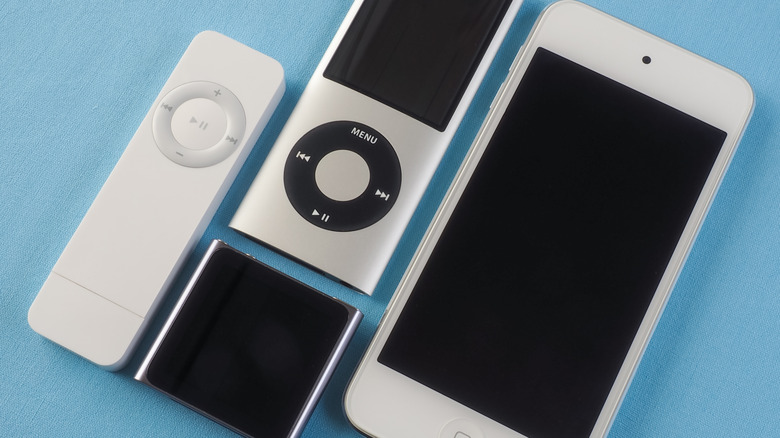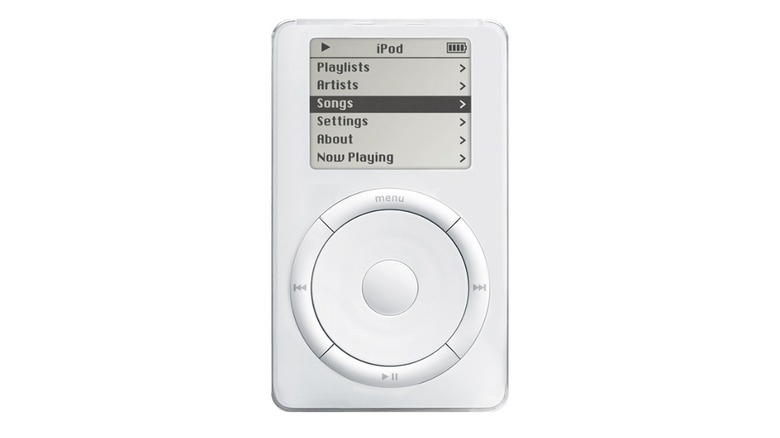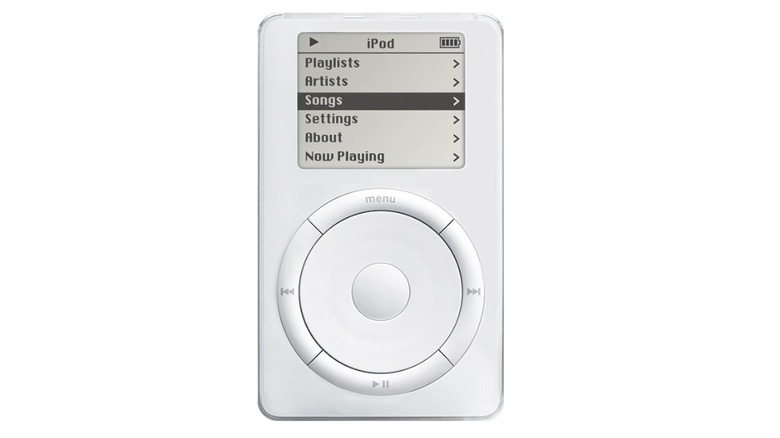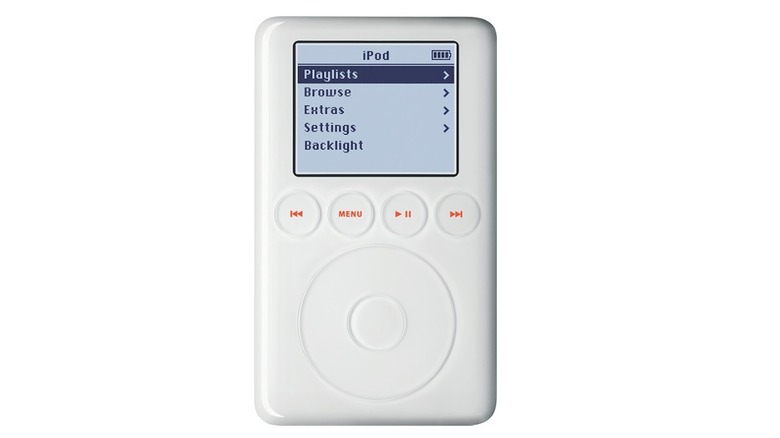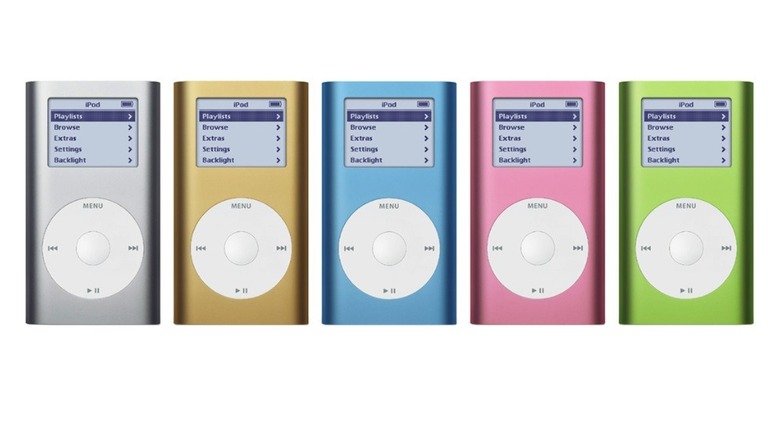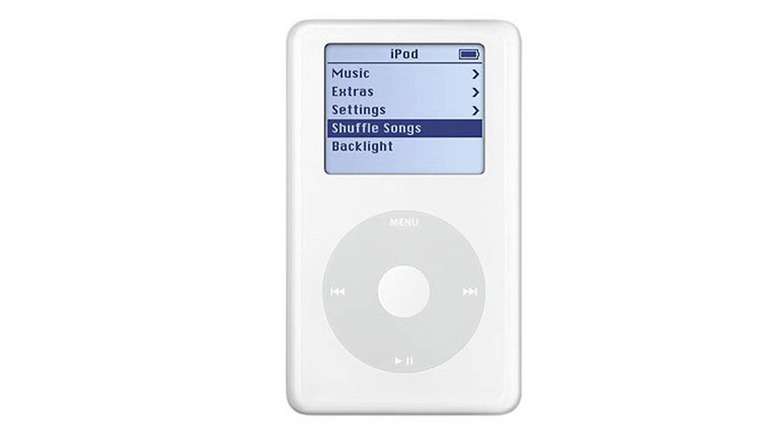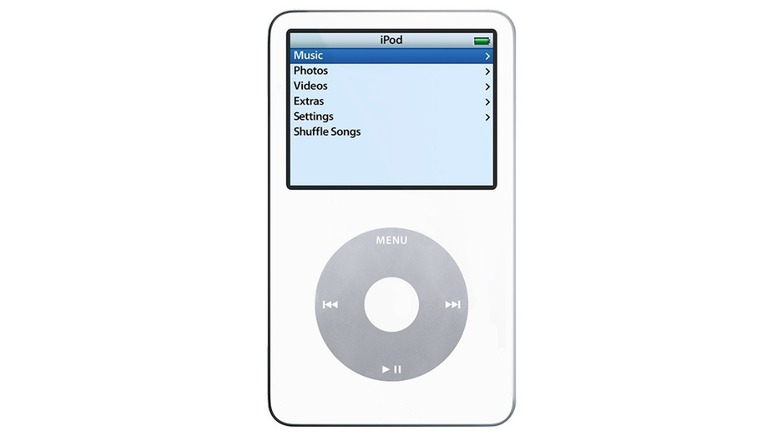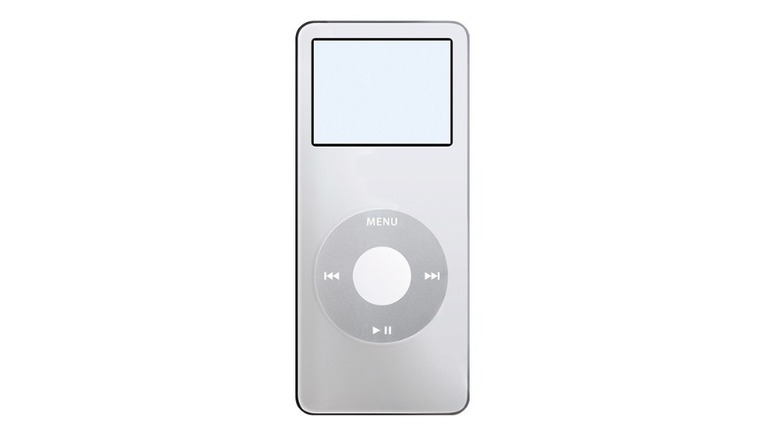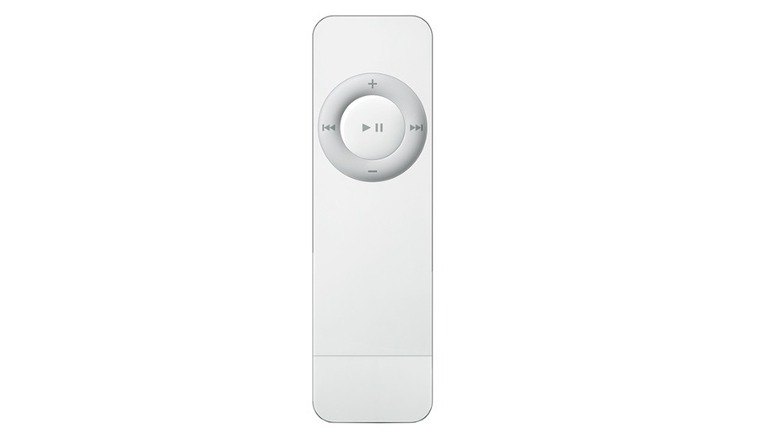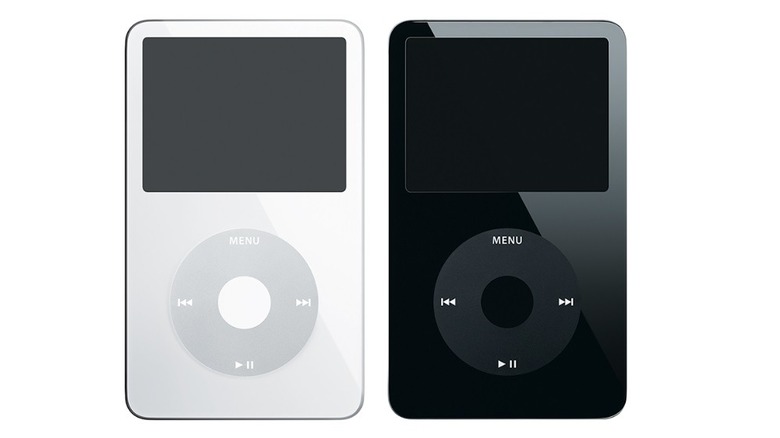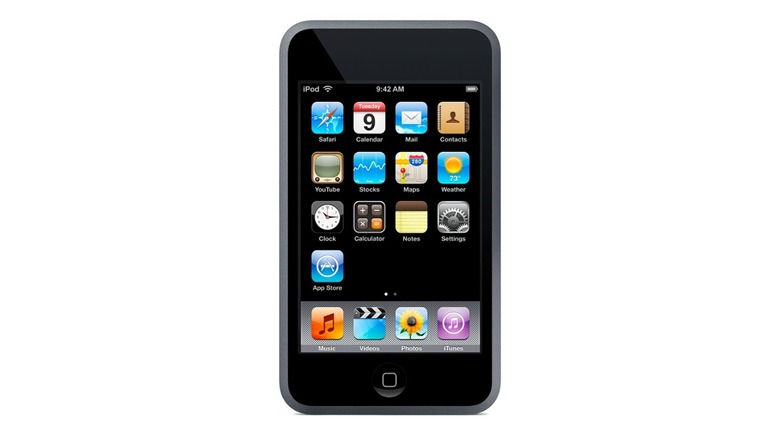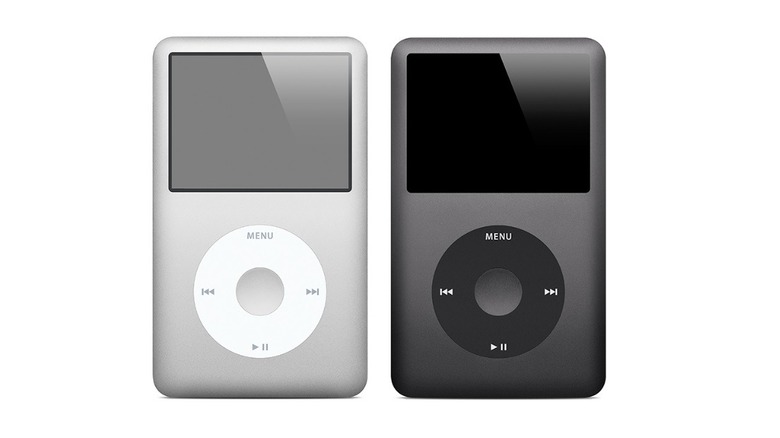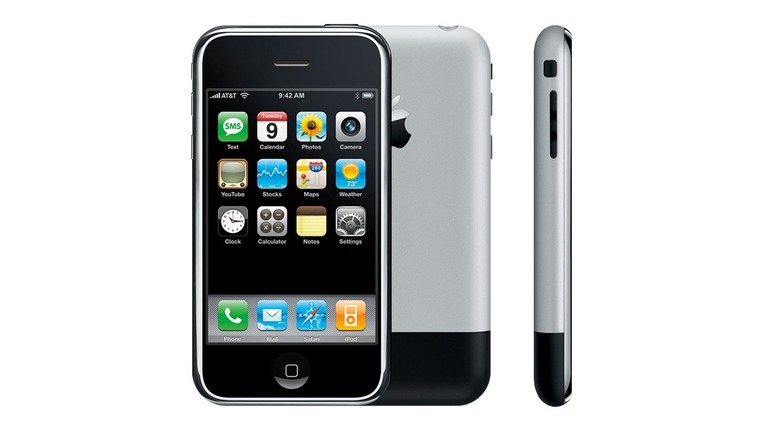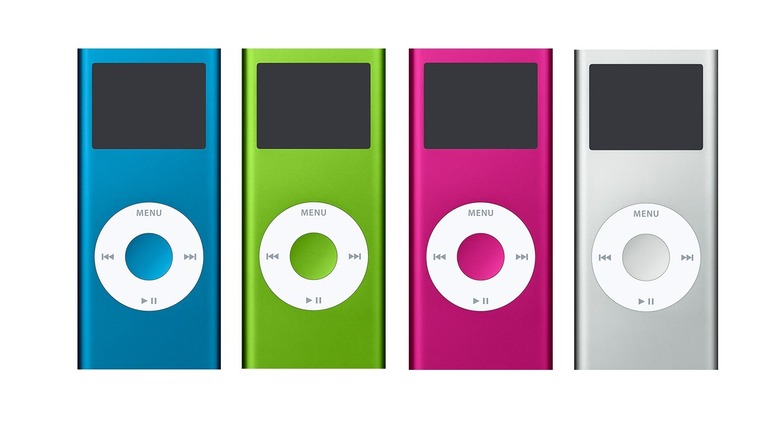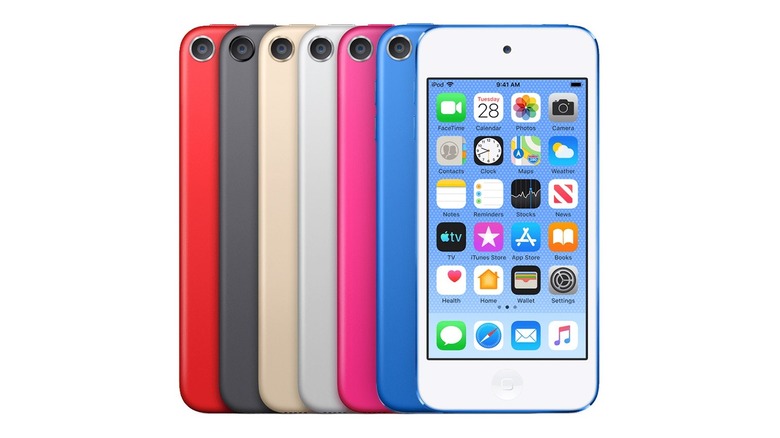The Transformation Of The Apple iPod From 2001 To 2022
In 1997, a developer for Advanced Multimedia Products named Tomislav Uzelac took advances in compression technologies and new file formats to create the world's first MP3 player, (per Encyclopedia). The burgeoning internet community took to the technology and innovated on top of it creating software interfaces and peer-to-peer sharing networks like Napster. Free to download song ripping software allowed people to convert their physical music collections into a digital library. For the first time, the average person's music could be untethered from physical media.
MP3 players were popular among tech enthusiasts, but the wider public was hesitant to adopt the new technology, at least until 2001. That year, Apple launched the iPod, a small piece of machinery that would become one of the company's flagship products. Certainly, Apple was a known entity before the iPod, having been a manufacturer of computers for decades by that point, but the success of the iPod is largely responsible for transforming Apple into the company it is today.
More than that, it pushed digital media to the masses, contributing to the modern age of music and video streaming we've all come to enjoy. For years, the iPod was a must-have gadget and synonymous with MP3 players. Modern iPods are almost unrecognizable when compared with their earliest counterparts, having evolved dramatically from 2001 to today.
The first iPod
Looking at it now, the original iPod appears like a dated piece of tech from the distant past, but at the time it was revolutionary. Before the iPod, you might have had an MP3 player that held a few dozen songs but even those were uncommon. Most people stored their collections of cassette tapes or CDs at home or in large booklets on the passenger seat of the car. The iPod reduced all of that down to something that could fit inside your pocket.
Announced on October 23, 2001, the iPod weighed in at 6.5 ounces, (per Apple) and had an incredibly intuitive interface. The 160-by-128-pixel display showed what was currently playing and a series of simple buttons let you navigate through your music library to find the right album or track.
The first iPod boasted ten hours of continuous playtime and the capacity for up to 1,000 tracks, enough to store all but the most prolific music listener's usual catalogue. In addition to ripping your physical collection onto the device, Apple also launched the iTunes store around the same time, allowing consumers to buy their music directly. Perhaps one of the best features was Apple's Auto-Sync technology, which automatically updated your iPod with your complete library whenever you plugged it in, eliminating the need to drag and drop files.
The iPod 2nd Generation
Building on the successful first model, Apple announced the second generation of iPod on July 17, 2002. On the outside, the iPod 2G looked strikingly similar to its predecessor, but it came with some significant updates and changes that improved the user experience and widened the market.
The most apparent physical change to the iPod's user interface was the way users could navigate. In place of the original scroll wheel, which physically turned, the iPod 2G introduced a touch-sensitive wheel, making scrolling even easier, (per Apple).
The iPod's insides were also beefed up. While the first iPod had only a 5GB storage option, the iPod 2G offered devices with 5GB, 10GB, or 20GB of storage with prices ranging between $299 and $499, depending on storage capacity. As a result, the potential storage of your player increased to approximately 4,000 tracks. Twenty gigabytes of maximum internal storage is almost laughable by modern standards but at the time it was more than consumers knew what to do with.
Perhaps the most important change made to the technology was its compatibility with Windows. The original iPod was only compatible with Macs, limiting market share to only those consumers who were already part of the Apple customer base. The 2G opened up the world of digital music players to consumers outside of Apple loyalists.
The iPod 3rd Generation
Following Apple's tendency to release new versions of its tech every year, 2003 brought us the third generation of the iPod. There were a number of changes to the external interface, the most apparent of which was a change to the control buttons.
While the third-generation iPod kept the touch-sensitive scroll wheel, the rest of the buttons shifted upward, perching between the wheel and the screen, (per Techable) which gave the third-generation iPod a less cluttered look. Backlighting was also added to the buttons, making them easier to use in low light. The change in layout turned out to be a point of contention among iPod users, however, as it made one-handed navigation a little more difficult.
The biggest change to the device, over the previous models, was the increased storage capacity. The iPod 3G offered up to 40GB of storage, allowing for an estimated 10,000 tracks, a full order of magnitude over the original device which had been released only two years earlier.
The iPod mini
The iPod mini was a testament to the fact that bigger isn't always better. The ability to add more tracks is great for the music aficionado, but for the average person, 1,000 songs was plenty. The mini targeted that portion of the consumer base by offering a slimmer device at a lower cost.
The same technological advances which allowed Apple to pack more songs into their previous devices, also allowed them to dial down to a smaller device while still being usable. The mini also introduces some novel changes to the external user interface. Instead of the plain white exterior, the mini came in a sleek metal case with the choice of silver, gold, pink, blue, or green, (per Apple History).
The mini was also the first iPod to introduce the Click Wheel. Instead of the buttons being separate from the wheel, they were integrated. That meant that one seamless piece offered both the touch sensitivity consumers had grown to love, and the ability to click at one of the four corners to access menus, pause and play, and move forward and backward through tracks, (per Apple).
The mini retailed for $249, roughly half the cost of Apple's more expensive models and was a perfect way for Apple to snag some of the more budget conscious consumers.
The iPod 4th Generation
The mini was Apple dipping its toes into new design schemes and that philosophy would come to dominate the iPod lineup as the years went on. The 4G represented the last of the old guard, still resembling in many ways, the original product. That isn't the say it was entirely the same old machine.
The 4G implemented the same Click Wheel technology introduced in the mini and it was the first iPod to introduce the shuffle function, allowing consumers to play their entire music library at random, (via Apple).
The 4G's internal specs were improved slightly over previous models, primarily in batter life, which could last for up to 12 hours of continuous play. Storage capacity was not increased, maxing out at 40GB, just as the 3G had. Apple did, however, drop the price.
Consumers could choose between a 20GB model for $299 and a 40GB model for $399. That means owners of the 4G got twice the storage as the top 2G model for $100 cheaper. The 40GB model also came standard with the iPod dock, allowing you to easily connect to a computer. It could be purchased as an accessory for the 20GB model, for an additional $39.
The iPod photo
Shortly after the 4G hit the scene, Apple announced another new toy, in the form of the iPod Photo. While the Photo was technically still part of the fourth generation series, (per Everyi), it packed some new features which would foreshadow what the iPod lineup was destined to become.
On the outside, it looked strikingly like the standard 4G, but its capabilities were next level. Internal storage options started at 40GB and capped at 60GB. That meant a potential music library of up to 15,000 songs. The battery was also improved, delivering 15 hours of playback.
As the name suggests, it was also capable of storing and displaying photos. In order to do that, they swapped out the standard monochrome display for a high-resolution color screen, (per Apple). Up to 25,000 photos could be stored in the 60GB version, which was a lot, especially before the age of Instagram.
If the relatively small display wasn't sufficient for sharing photos with family and friends, an integrated TV-out port allowed users to connect the device to a television in order to display their pictures on a larger screen. In addition to personal photos, the color screen an image capability also allowed for the display of album artwork, enhancing the music experience which made the iPod famous to begin with.
Looking back, the Photo was the first hint of the truly all-purpose devices Apple would make a few years down the line.
The iPod nano
Released in 2005, the nano built on the philosophy of the mini by going even smaller. With a maximum storage capacity of 4GB, it didn't offer anywhere near the track capacity of its larger and older siblings, but it did come in at a significantly lower price point. While an iPod photo would set you back five or six hundred dollars, a nano could be had for as little as $149, (per CNET). That made it appealing to consumers who might be resistant to dropping hundreds of dollars on a new piece of tech and placed it firmly within the birthday or holiday gift realm.
The nano integrated the recently unveiled photo capability and the color screen, although it did not have the ability to connect to a television for viewing. Even with its lower storage capacity, it was still capable of holding up to 1000 songs in the 4GB version. The biggest complaint people had about the nano related to the new shell, which was prone to scratching, (per Pocket Lint).
Despite, and perhaps even because of, its pared down specs the nano succeeded in expanding the iPod's footprint to users who might otherwise not have put their money down on a digital music player.
The iPod Shuffle
In case the nano wasn't small enough for you, Apple also released the iPod Shuffle in 2005, their smallest, simplest, and most affordable iPod to date. On one end of the lineup, Apple was working to pack as much functionality as possible into their devices. On the other end, you had the Shuffle, stripped of all but the most crucial functions.
The Shuffle had no screen and the whole configuration was smaller than a pack of gum, (per Apple) with a few buttons adhered to its face. The Shuffle was offered in two options, a 512MB version which could hold up to 120 songs and a 1GB version which held twice as much.
Moreover, because there was no screen, users couldn't easily navigate through their music libraries. Instead, it utilized the Shuffle function introduced in the 4G for all playback. Once tracks were loaded, it played them all at random. While the functionality of the shuffle was significantly reduced, so too was the cost. The 512MB shuffle came in at $99.
Later versions of the Shuffle shifted from tall and skinny to square-shaped, making them even smaller.
The iPod 5th Generation with video
While 2005 brought us both the mini and the nano, it wasn't all about getting smaller and simpler. That same year Apple released the fifth-generation iPod which included video capability for the first time.
The 5G utilized the same sleek face material as the nano, with options in black or white, and a stainless-steel backing, (per Everyi). The body of the devices were slimmer than previous generations while still packing up to 60GB of storage capacity.
The 60GB model, which retailed at $399, boasted up to 15,000 tracks, 25,000 photos, 150 hours of video, (per Apple), or some combination of the three. It maintained the previous photo capability and could store photos pulled from a computer or transferred directly from a camera using the iPod Camera Connector.
The 2.5-inch screen, though small, was capable of playing back video on the device itself for watching content on the go and an included AV cable allowed that same content to be displayed on a television. It also contributed to the brief popularity of enhanced podcasts, which included visual elements alongside the usual audio.
The iPod touch
The iPod touch, announced in September of 2007, represented a turning point in Apple's flagship product. Gone were the scroll wheels and buttons of any kind, aside from the wake/home button at the bottom and a locking key at the top.
As the name suggests, the touch accomplished all navigation by utilizing a touchscreen and Apple's multi-touch interface. As a result of no longer needing physical buttons, the screen was expanded to 3.5 inches.
It was initially offered with 8GB or 16GB of storage, retailing at $299 and $399 respectively, (per Apple). By this point, the iPod barely resembled its ancestors from only six years earlier and was more akin to contemporaneous smartphones, only without the actual phone features.
In addition to playing music and displaying photos or videos, the touch also integrated applications like the Safari web browser and YouTube. Built-in Wi-Fi and access to iTunes directly on the device meant that users were no longer tethered to their computers. Content could be discovered and acquired directly from the iPod itself.
The iPod classic
While Apple was shifting to slimmer, more capable devices like the iPod touch, they left a little room in their lineup for nostalgia, at least for a while. On the same day the touch was announced, Apple also unveiled a new iPod that more closely resembled the lineup's roots.
While the touch offered greater functionality, it lacked the focused purpose of a pure media player. The classic was the perfect option for someone who wanted a dedicated media player without all the bells and whistles. Its design aesthetic was much closer to the earlier iPods, hearkening back to the screen up top and the beloved button and scroll wheel combination.
In exchange for losing multi-touch navigation and Wi-Fi, the classic offered up to 160GB of storage capacity, carrying up to 40,000 tracks. They did keep the color screen as well as photo and video capabilities and a handful of games, (per Apple).
As explained by Cnet, the classic also incorporated the Genius feature, which let your iPod create automated playlists based on the characteristics of a single song. The classic was the consumer's last opportunity to grab hold of a piece of quickly antiquated but historic portable media tech before the world moved on without it.
The iPhone
While not strictly an iPod, we can't tell the story of the iPod without at least mentioning the first iPhone. In fact, during a conversation in 2007, Steve Jobs referred to the iPhone as the best iPod they had ever made, (per Engadget).
Announced in January of 2007, several months before the release of the iPod touch, the iPhone took all of the innovations which had been built up in the iPod line over the previous six years and changed the cellphone landscape forever. It's impossible to look at modern smartphones, even fifteen years later, and not see the DNA of the first iPhone in there somewhere.
Most importantly, as it relates to the iPod, the iPhone incorporated iTunes and music storage. Now, having an iPhone meant having an iPod by default. We can trace a straight line from modern mobile music streaming back to the iPhone.
By incorporating all of the iPod's best features into a mobile phone, consumers no longer needed to have a dedicated media device. We may not have realized it at the time, but the iPhone was the first step on a road toward the decline and looming death of the iPod.
Updated shuffles and nanos
Over the years, Apple delivered new versions of both the shuffle and the nano, varying the designs and internal specs.
As explained by The Verge, the nano ultimately went through eight generations, experimenting with different color schemes, functionalities, and shapes. The third generation made the nano almost square, in order to allow for a wider screen capable of playing video in something approximating a normal aspect ratio, but that was later abandoned. Perhaps the weirdest nano came in 2010 when it was reduced down to a small square that was all screen. The final generations returned to the business card shape while keeping the touchscreen functionality.
The shuffle also went through a few different design variations during its four-generation run. The gum stick design was quickly replaced by a simple square filled with buttons. The third generation went back to a tall and slim design almost resembling a thumb drive, with no buttons at all. Instead, it was controlled by buttons on the headphones, (per Lifewire).
As smartphones became more ubiquitous, the nano and the shuffle suffered from a lack of demand. The last shuffle was released in 2010 and the last nano in 2015. Both products were ultimately discontinued in 2017, (per CNBC).
The last iPod?
While the iPod's popularity waned significantly in the wake of the iPhone and competing smartphones, the product line has continued on. After the iPod classic, Apple focused most of its attention on updated versions of the iPod touch.
Most recently, the touch was updated in May of 2019 with the release of its seventh generation, (per Apple). Starting at $299, the latest touch comes with 256GB of storage for downloading music, images, and videos.
Building on the very first iPod touch, the latest version is barely distinguishable from a comparable iPhone. The incorporation of FaceTime and iMessage means that users can even send messages and make calls as long as they're on a wireless network. All of its functionality aside, there's nothing an iPod touch can do that a basic smartphone can't. As such, they've mostly become a go-to device for children not yet ready for full-fledged phones.
At present, the iPod touch is the only version of the iPod available from Apple and they haven't updated it in several years. Moreover, there's not really a good reason that they should. It's likely the touch will soon go the way of the nano and the shuffle and the iPod, innovative as it was, will cease to be.
